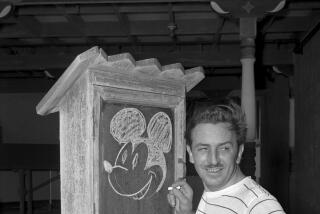Roy Edward Disney, more than a famous name
- Share via
Roy Edward Disney, who died Wednesday at the age of 79, was loved and respected within the animation industry as a link to the art form’s glorious past, a defender of its exciting, chaotic present and a hope for its often-uncertain future. As the son of Walt’s brother, Roy Oliver Disney, he was animation royalty: He even looked like his uncle and spoke in a similar voice, roughened by smoking.
In person, he was genial and soft-spoken, with a warm chuckle that enlivened his favorite stories, as in the 1985 interview when he told me, “I like to say my first exposure to animation came when my mother inked and painted cels of Mickey Mouse while she was pregnant with me.”
After the Disney Co. fought off Saul Steinberg’s takeover bid in June 1984, Roy led the move to replace Walt’s son-in-law, Ron Miller, with a new management team from live action: Michael Eisner, Frank Wells and Jeffrey Katzenberg. When the new leaders launched an ambitious program of live-action production, rumors spread that the animation department might be eliminated -- fueled by the decision to move the artists off the lot and convert the historic animation building into offices. Those fears were allayed when Roy took charge of the department and set up new headquarters in Glendale.
Roy recalled in 1989, “The morning of the board meeting, when it was all over and Michael and Frank had been elected to the company, Michael looked at me and said, ‘Now that this is all over with, what do you want to do?’ After about 15 seconds, I said, ‘Why don’t you give me animation?’
“Of all the bits and pieces of this place, it was probably the hardest thing to understand -- particularly for people who were used to conceiving, shooting and releasing a film in nine months,” he continued. “I figured, I grew up around it, I must know something about it, by osmosis, if nothing else. I was appalled to learn how little I did really know; I think all of us were appalled to learn how little we really knew.”
Roy learned fast, and his leadership helped to spark the Disney renaissance of the late 1980s and early ‘90s, the era of “The Little Mermaid,” “Who Framed Roger Rabbit?” “Beauty and the Beast,” “Aladdin” and “The Lion King.” Roy was a warm, approachable man whom the animators could talk to and caricature, knowing their comments would be received with respect and affection.
But Roy was more than a boss: He was also a link to Walt, whose spirit hovered over his studio long after his death in 1966. When Roy had the chickenpox as a boy, Walt came to visit and spent the better part of an hour sitting on his bed, telling him the story of “Pinocchio,” which the studio had just begun.
Roy said in a 1989 interview that when he saw the finished film, “It was nowhere near as good as when Walt told it. I’ve seen it recently, and realize what a splendid piece of work it is. But there’s still that funny little aftertaste of Walt’s performance, and the knowledge that it could have been that much better.”
For animators and animation lovers, that was the Golden Age, and talking to Roy about Walt was like getting stories about Achilles from a veteran of the Trojan War.
When the Disney animated features scored unprecedented box office and financial successes, culminating in “The Lion King” in 1994, Roy was constantly being asked what his father and uncle would think of the studio’s new preeminence.
He replied, “Walt would probably say, ‘You haven’t come far enough fast enough.’ I always feel Walt isn’t looking over our shoulders, he represents a level of excellence that makes you work harder to live up to it. His films are always the damned carrot in front of the donkey.”
In 1998, when his father received a star on Hollywood Boulevard, Roy offered what became his definitive response, “Second-guessing either one of those guys is a futile exercise. Guys were fired for second-guessing Walt for many years; I wouldn’t want to try it with Dad, either -- I may see him again.”
If Roy should see his father and Walt again in an animated afterlife, I suspect they’ll thank him for preserving their legacy.
And millions of animation fans will agree.
Charles Solomon’s 10th book about animation, “Tale as Old as Time: The Art and Making of ‘Beauty and the Beast,’ ” will be published next summer by Disney Editions.
More to Read
The biggest entertainment stories
Get our big stories about Hollywood, film, television, music, arts, culture and more right in your inbox as soon as they publish.
You may occasionally receive promotional content from the Los Angeles Times.










